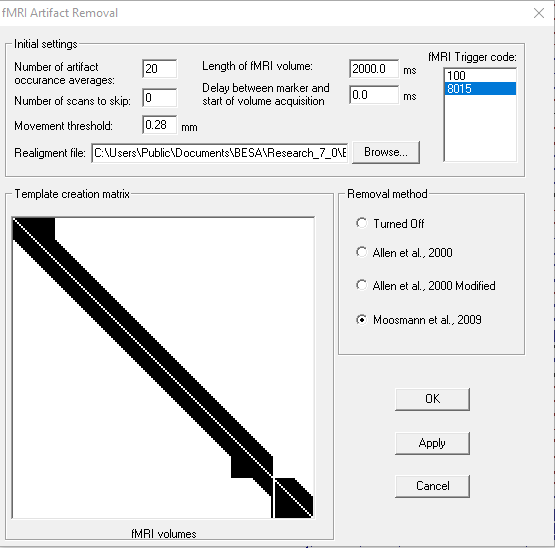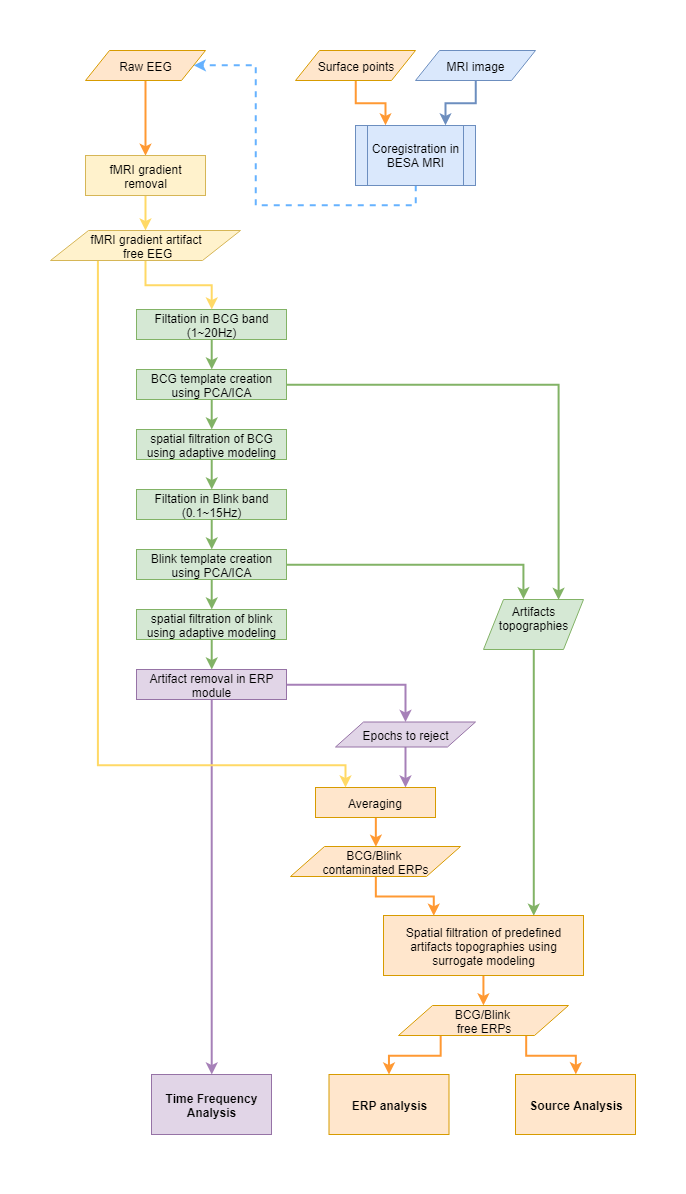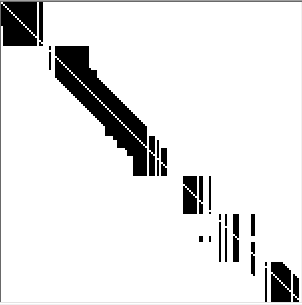Difference between revisions of "Pipeleline for simulatneus EEG-fMRI recording"
From BESA® Wiki
| Line 41: | Line 41: | ||
* Number of artifact occurrence averages - The default value is 16. That means that 8 preceding and 8 proceeding artifact occurrences are used to create averaged template. Note that if odd number is used (ie. 17) the signal from volume currently correcting is used for averaging as well. If a larger number is selected then the artifact is more stable and differentiated from EEG data. However if there is a lot of movement during the recording session the artifact template will be incorrect. A smaller number of artifact occurrences for averaging or more advanced methods of artifact removal should be selected. | * Number of artifact occurrence averages - The default value is 16. That means that 8 preceding and 8 proceeding artifact occurrences are used to create averaged template. Note that if odd number is used (ie. 17) the signal from volume currently correcting is used for averaging as well. If a larger number is selected then the artifact is more stable and differentiated from EEG data. However if there is a lot of movement during the recording session the artifact template will be incorrect. A smaller number of artifact occurrences for averaging or more advanced methods of artifact removal should be selected. | ||
* Movement threshold - this parameter is only used for two advanced methods: Allen et al. 2000 Modified and Mossmann et al. 2009. When changing this value check how the template creation matrix changes. if you note that matrix is very segmented (check below) you might consider increasing the threshold value | * Movement threshold - this parameter is only used for two advanced methods: Allen et al. 2000 Modified and Mossmann et al. 2009. When changing this value check how the template creation matrix changes. if you note that matrix is very segmented (check below) you might consider increasing the threshold value | ||
| + | |||
[[File:FMRI_distorted_matrix.PNG]] | [[File:FMRI_distorted_matrix.PNG]] | ||
Revision as of 10:14, 10 April 2018
| Module information | |
| Modules | BESA Research Basic or higher |
| Version | 7.0 or higher |
Contents
Pipeline for simultaneous EEG-fMRI recording
Before you start
- You have a clock synchronization between EEG and MRI systems
- You have jitter between trials in ERP experiment (i.e. random value of ±200ms). Some further guidelines about paradigm creation can be found here: (Rusiniak et al., 2013a).
- The subject movement is limited to minimum.
- Electrode to skin impedance is as low as possible.
- EEG-fMRI recording session was long enough to allow for proper artifact creation. Usually experiment should last at least 6 minutes.
- Especially for first few registrations repeat the experiment outside of the bore to compare results.
Pipeline overview
The recommended pipeline of processing EEG data registered during fMRI session looks as follows:
Please note that some steps are grouped with colors:
- orange color indicate steps that are part of typical processing of ERP data.
- blue color indicate optional, yet strongly recommended EEG-MRI data co-registration.
- yellow color marks the steps related to fMRI gradient artifact removal
- green steps are reserved for BCG/blink artifact correction
- violet color indicate steps for time frequency analysis. Here also information about rejected epochs is provided for averaging.
fMRI gradient removal
To remove fMRI gradient go to menu Artifact\fMRI artifact... Following dialog box will appear:

Some of the parameters are strongly dependent on fMRI acquisition:
- Length of fMRI volume - it should be exactly the time of volume acquisition (time when MR gradients are ON).
- fMRI trigger code - code in the EEG recording provided by MR scanner.
- Delay between marker and start of volume acquisition - a delay between marker in EEG provided by MR scanner and real start of fMRI volume acquisition.
- Number of scans to skip - if MR volumes acquired to stabilize magnetization has a corresponding marker in EEG data adjust this value to match number of volumes used for fMRI analysis.
- Realignment file - direct output file from first step of fMRI analysis (realignment). We support SPM, FSL, AFNI, Brainvoyager
Other should be carefully selected depending on the data:
- Number of artifact occurrence averages - The default value is 16. That means that 8 preceding and 8 proceeding artifact occurrences are used to create averaged template. Note that if odd number is used (ie. 17) the signal from volume currently correcting is used for averaging as well. If a larger number is selected then the artifact is more stable and differentiated from EEG data. However if there is a lot of movement during the recording session the artifact template will be incorrect. A smaller number of artifact occurrences for averaging or more advanced methods of artifact removal should be selected.
- Movement threshold - this parameter is only used for two advanced methods: Allen et al. 2000 Modified and Mossmann et al. 2009. When changing this value check how the template creation matrix changes. if you note that matrix is very segmented (check below) you might consider increasing the threshold value

